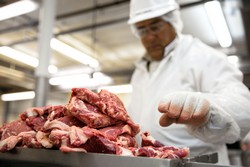Automated fat analysis of meat products
Meat products such as hamburgers and sausages consist of meat trimmings, mainly from pork or beef or a mixture of both. The trimmings are produced at the abattoir and sold either fresh or frozen to meat processors in standard plastic bins. However, the visual classification of trimming bins is imprecise and their contents can vary. By precisely controlling fat content, problems such as poor texture and appearance, excessive drying and product spoilage can be avoided. The project TRIMSCAN(opens in new window) (TRIMSCAN, making SME meat processors more competitive by using automatic in-line fat analysis in meat trimmings) developed an automatic method for determining fat content in plastic bins. The solution was a contactless in-line fat analyser based on magnetic induction that scans 100 % of pork and beef trimming in the plastic bins to determine the passive dielectric properties of meat. Furthermore, this low-maintenance technology can be easily adapted to match the speed of the processing line and does not require modification of the plant layout. TRIMSCAN developed a laboratory prototype that included a conveyor belt, which passed the trimming bins through the electromagnetic scanner. Electromagnetic sensors, an electromagnetic shield, and an electronic instrumentation and control system were used for analysis. Now small-scale meat processors can obtain meat trimmings with a specific fat content using TRIMSCAN technology. This would help them reduce the overuse of expensive lean meat as well as avoid inaccurate and expensive manual sampling and the need for reformulating recipes. Furthermore, the quality of the final product is improved by reducing the percentage of rejections due to products failing to meet the requirements of customers and/or legislation. TRIMSCAN will raise the standards of meat processing within the EU and contribute to the continued growth of the EU meat sector. The European meat industry will be able to consistently produce better quality meat products with fewer losses while increasing consumer confidence.



